Related Research Articles

The Leonard P. ZakimBunker Hill Memorial Bridge is a cable-stayed bridge completed in 2003 across the Charles River in Boston, Massachusetts. It is a replacement for the Charlestown High Bridge, an older truss bridge constructed in the 1950s.

Othmar Hermann Ammann was a Swiss-American civil engineer whose bridge designs include the George Washington Bridge, Verrazzano-Narrows Bridge, and Bayonne Bridge. He also directed the planning and construction of the Lincoln Tunnel.
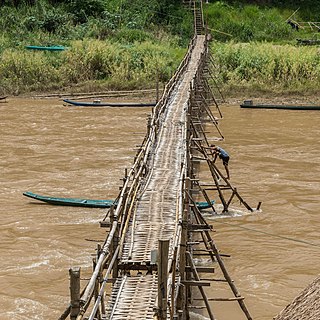
A footbridge is a bridge designed solely for pedestrians. While the primary meaning for a bridge is a structure which links "two points at a height above the ground", a footbridge can also be a lower structure, such as a boardwalk, that enables pedestrians to cross wet, fragile, or marshy land. Bridges range from stepping stones–possibly the earliest man-made structure to "bridge" water–to elaborate steel structures. Another early bridge would have been simply a fallen tree. In some cases a footbridge can be both functional and artistic.
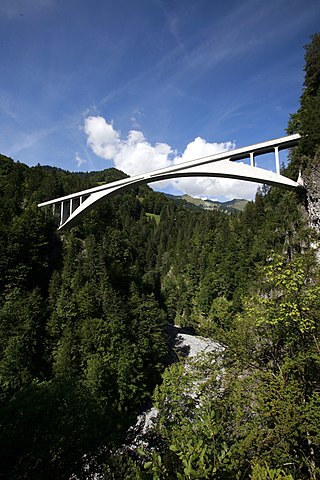
Salginatobel Bridge is a reinforced concrete arch bridge designed by Swiss civil engineer Robert Maillart. It was constructed across an alpine ravine in the grisonian Prättigau, belonging to the municipality of Schiers, in Switzerland between 1929 and 1930. In 1991, it was declared an International Historic Civil Engineering Landmark, the thirteenth such structure and the first concrete bridge so designated.

The Mezcala Bridge, is a cable-stayed bridge located in the state of Guerrero on Highway 95D in Mexico. It spans the Balsas River close to the western Pacific coast of the country. This bridge, with a total length of 891 m (2,923 ft) and six uneven spans completed in 1993, has been in service since 1994 as a toll bridge.
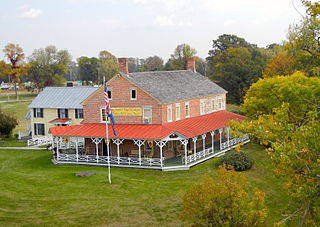
Chimney Point is a peninsula in the town of Addison, Vermont, which juts into Lake Champlain forming a narrows. It is one of the earliest settled and most strategic sites in the Champlain Valley.

The Champlain Bridge was a 2,184-foot-long (666 m) vehicular bridge in the United States that traversed Lake Champlain between Crown Point, New York and Chimney Point, Vermont. It was opened to traffic in 1929 as a toll bridge; the tolls were removed in 1987. The bridge was closed due to safety concerns on October 16, 2009, and was taken down by explosive demolition on December 28, 2009. It was replaced by a new bridge which opened on November 7, 2011.

HNTB Corporation is an American infrastructure design firm. Founded in 1914 in Kansas City, Missouri, HNTB began with the partnership made by Ernest Emmanuel Howard with the firm Waddell & Harrington, founded in 1907.
TYLin is a global, multi-disciplinary infrastructure services firm. Headquartered in San Francisco, TYLin established its business in the design of long-span bridges and specialty structures.
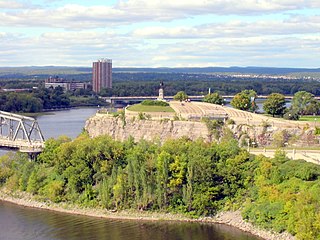
Kìwekì Point, formerly Nepean Point is a hill overlooking the Ottawa River in Ottawa, Ontario, Canada. It is located between the National Gallery of Canada and Alexandra Bridge. The site is managed by the National Capital Commission (NCC).

The Union Arch Bridge, also called the "Cabin John Bridge", is a historic masonry structure in Cabin John, Maryland. It was designed as part of the Washington Aqueduct. The bridge construction began in 1857 and was completed in 1864. The roadway surface was added later. The bridge was designed by Alfred Landon Rives, and built by the United States Army Corps of Engineers under the direction of Lieutenant Montgomery C. Meigs.

John Ochsendorf is an American educator, structural engineer, and historian of construction; he is a professor in the Department of Architecture and the Department of Civil and Environmental Engineering at the Massachusetts Institute of Technology. He is widely known for becoming a MacArthur Fellow in 2008 He served as the Director of the American Academy in Rome from 2017 to 2020. In 2022, he was appointed the founding director of the newly created MIT Morningside Academy for Design.

The Lake Champlain Bridge is a vehicular bridge traversing Lake Champlain between Crown Point, New York and Chimney Point, Vermont. It replaced an older bridge that was demolished in 2009. The bridge was designed and constructed during an aggressive two-year schedule to minimize the social and economic impact of the original bridge's demolition. It is the only fixed-link crossing of Lake Champlain/Champlain canal between US 4 in Whitehall, 42 miles (68 km) to the south and US 2 at Rouses Point, 85 miles (137 km) to the north.

Certain works of structural engineering design are also works of structural art. Such works can be classified as structural art when they attain excellence in the three areas of efficiency, economy, and elegance, as defined by Prof. David P. Billington of Princeton University. A key part of the concept of structural art is that the structural engineer making the design must exercise his or her creativity and playfulness to create an elegant structure within the constraints imposed by engineering requirements. These constraints include the safety and serviceability of the structure. Therefore, a structure cannot be a successful work of structural art without also being a successful work of structural engineering design, yet many works of structural engineering design that are safe and serviceable do not rise to the level of structural art because they fail to be economical, efficient, or elegant. Structural art is a topic of active scholarly research at several universities in the United States, including Princeton University, Tufts University, Bucknell University, University of Massachusetts Amherst, the Massachusetts Institute of Technology, and Roger Williams University, and in other parts of the world such as Spain and Germany. While structural artists often collaborate with architects, the discipline of structural art is based upon engineering rather than architectural design. A recent summary about this topic can be found in a review paper.
Princeton University School of Engineering and Applied Science is located in Princeton, New Jersey, United States. A school within Princeton University, which is one of the eight universities of the Ivy League, it provides undergraduate and graduate instruction in six departments: chemical and biological engineering, civil and environmental engineering, computer science, electrical engineering, mechanical and aerospace engineering, and operations research and financial engineering. It has more than 1,400 undergraduates, 620 graduate students and 147 faculty members in its six departments.
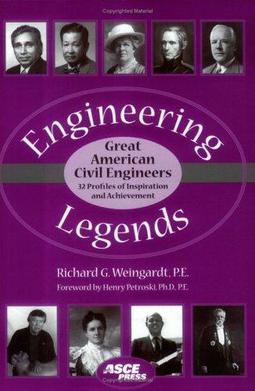
Engineering Legends: Great American Civil Engineers is a 2005 book by engineer Richard Weingardt. The book features a list of 32 engineering legends from the 1700s to the present, including Fazlur Khan, Hal Iyengar, Tung-Yen Lin, Benjamin Wright, and Fred Severud.

Juan Sobrino is a civil engineer, known internationally for designing more than 400 bridges, introduction of advanced materials in bridges and innovative bridge designs. He is the founder of Pedelta, an international structural engineering firm.
Anand Swarup Arya (1931-2019) was an Indian structural engineer, known for his expertise in the soil and foundation engineering and earthquake disaster management. He is a former chairman of the Bureau of Indian Standards (BIS) Committee on Earthquake Engineering and a recipient of the United Nations Sasakawa Disaster Prevention Award of 1997. The Government of India awarded him the fourth highest civilian honour of the Padma Shri in 2002.

Squibb Park Bridge is a footbridge connecting Brooklyn Bridge Park and Squibb Park in Brooklyn Heights in Brooklyn, New York City. It is the second of two bridges on the same site. The original bridge opened in March 2013 and was demolished in late 2019, being replaced by the current bridge in April 2020. It is named after inventor and manufacturer of pharmaceutics E. R. Squibb.
References
- 1 2 "Theodore P. Zoli, PE | HNTB". Archived from the original on 2010-12-31. Retrieved 2010-01-03.
- ↑ "Theodore Zoli". macfound.org.
- ↑ "Local Genius". adriondackalmanack.com. 8 January 2010.
- ↑ "Theodore Zoli – MacArthur Foundation". macfound.org.
- ↑ Chiarella, Tom (22 November 2010). "Theodore Zoli: Bridge Engineer". Esquire. Retrieved 22 December 2019.
- ↑ Barron, James (2019-10-29). "$7.5 Million 'Down the Drain': The Demise of the Bouncing Bridge". The New York Times. ISSN 0362-4331 . Retrieved 2019-10-30.
- ↑ Plitt, Amy (December 4, 2018). "Brooklyn Bridge Park will replace problem-plagued Squibb Bridge". Curbed NY. Retrieved November 20, 2019.